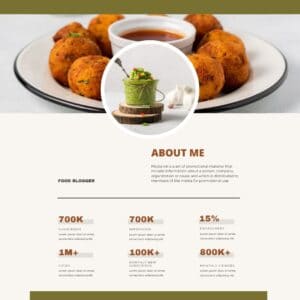A well crafted media kit for food entrepreneurs is essential for perfecting your pitch if you want to secure partnerships and to promote your business. You know you have amazing food, great customer service, and a unique brand story, but how do you convey all of that to potential partners in a way that’s professional and concise?

What is a media kit?
A media kit for food entrepreneurs and bloggers is like a resume to show off their brand and services. It can be really helpful if you want to work with food brands or get sponsorships.
Why is a media kit for food entrepreneurs so important?
A well-designed media kit could help you stand out from your competition. Remember, you are not the only pitching your services, so you want to grab their attention. Keep it visually interesting by using high-quality images of your work and incorporate your brands colours in your design.
Additionally, it can save you time and effort when it comes to pitching your business. Instead of having to type out a long email or make a phone call, you can simply send your media kit and let it do the talking for you. This can be especially helpful if you’re reaching out to a lot of potential partners at once and don’t have time to craft individual messages.
What should food entrepreneurs include in their media kit?
1. An Introduction:
Introduce yourself and your brand. Add a short story about how and why you started your business and what sets you apart from your competitors.
2. Describe your services:
Give an overview of your services and available collaborations, such as recipe development, sponsored posts or product reviews etc.
3. Audience Demographics:
Describe your audience or customers. Are they mostly young adults? Families with children? Corporate clients? This will help other companies understand who your business caters to.
4. Statistics:
Include statistics such as social media following, website traffic, customer reviews, sales figures or how many customers you serve in a week.
5. Previous collaborations:
Add any previous partnerships that you have done. This will show that you’re experienced in working with other businesses and can help build trust with potential partners.
6. Testimonials/Reviews:
Share positive feedback, reviews or case studies from satisfied customers or collaborations to demonstrate your brand’s credibility.
7. Tailor your media kit to your audience:
Make sure your media kit is tailored to the specific audience you’re targeting. If you’re trying to attract sponsorships from food brands, for example, make sure your media kit speaks directly to their interests and needs.
8. Contact details:
Finally, be sure you include your contact information, so that potential partners can reach out to you.
By taking the time to create a well-designed media kit, you have the opportunity to make a good first impression. So don’t skip this step – invest the time and effort into crafting a media kit that truly showcases your brand and all it has to offer to stand out in a competitive market!

